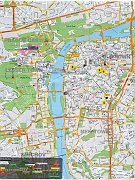| Around 870: Foundation of Prague Castle.
Around 926: Foundation of St. Vitus Cathedral in the grounds of Prague Castle.
965: Prague first reported in the narration of Ibrahim Ibn Jakub, a merchant.
973: Foundation of Prague bishopric (principality ruled politically by a prince-bishop).
10th century: Foundation of Vysehrad on the opposite bank of the Vltava river.
1085: Prague becomes the residence of the first Bohemian King Vratislav I.
1172: Construction of Judita´s Bridge, the 2nd stone bridge in Central Europe. |
Around 1230: Establishment of the Old Town.
1257: Foundation of Mala Strana.(district referred to as "Lesser Town")
1310-1346: John of Luxembourg rules as the king of Bohemia.
Around 1320: Foundation of Hradcany, the area around Prague Castle.
1338: Foundation of the Old Town Hall - the importance of the city increases.
1344: Prague bishopric upgraded to archbishopric, beginning of St. Vitus, St. Wenceslas and St. Adalbert Cathedral (finished 1929).
1346-1378: Charles IV epoch - Prague becomes the capital of the Bohemian Kingdom and the Holy Roman Empire.
1348:Foundation of the New Town and Charles University, the first university in Central Europe.
1419-1437: Attempts of the clergy to reform the church result in the Hussite's revolutionary movement (Jan Hus - the reform preacher and martyr).
1526: The Hapsburg dynasty ascends the Bohemian throne (lasts until 1918).
1583-1611: Rudolf II becomes the king of Bohemia. Prague becomes the emperor's residence and the centre of social and cultural life.
1618-1620: Defeat of the Czech nobles´ uprising; Czech language and Czech national consciousness begin to decline.
1784: Union of the four hitherto independent Prague urban units (Hradcany, Lesser Town, Old Town and New Town).
1784-1848: Period of Czech national revival, beginning of the industrial revolution, establishment of Czech institutions. | 1918: Proclamation of the independence of Czechoslovakia. Prague becomes the capital of the new state.
1939-1945: Occupation by Nazi Germany.
1945: The Prague uprising, "liberation" of Prague by the Soviet army.
1948: Seizure of power by KSC after the February putsch.
1968: Prague Spring - an attempt to reform socialism, intervention of 5 states of the Warsaw Pact.
1989: Velvet revolution, Vaclav Havel elected President of Czechoslovakia.
1990: First free elections.
1993: January 1, Czechoslovakia splits in two and the Czech Republic is founded.
1993: January 26, Vaclav Havel elected first president of the Czech Republic.
1999: March 12, Czech Republic becomes a member of NATO.
2004: May 1, Czech Republic joins the European Union (E.U.).
2008: January 1, Czech Republic accedes to the Schengen agreement and removes internal borders with Schengen area countries. This allows travel to and from these countries without checks, both at land borders and airports. | |
|




